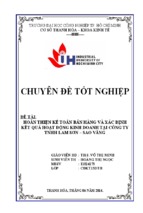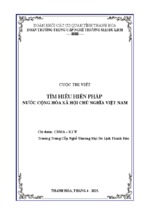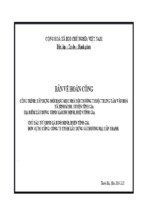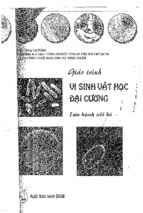NHA TRANG UNIVERSITY
Faculty of Food Technology
Specialized English in Food Technology
Van Tang Nguyen, PhD
September 2019
Contents
Introduction to subject
Basic concepts and definitions
Special topics in food technology
Special topics in food technology
1. Tropical products: tea, coffee, cocoa, cashew and pepper
2. Fruits and vegetables
3. Fermented products: wine, beer, beverages and other foods
4. Milk and milk-originated products
5. Canned foods
6. Food oils and fats
7. Cane sugar
8. Bakery and confectionary
9. Functional foods
10. Food safety
11. Machines and equipments in food processing
12. New trends in food science and technology
Assessment
1. Attendance/attitude: 10%
2. Exercise(s) (40%): Class exercises, home works and
student’s presentations
3. Final exam (50%): Reading and writing
References
[1] International Food Information Service. 2009. Dictionary of Food
Science and Technology (second edition). Wiley-Blackwell.
[2] Bùi Đức Hợi và cộng sự. Từ điển công nghiệp thực phẩm Anh Việt. NXB Khoa học và Kỹ thuật.
[3] Nguyễn Thị Hiền (Chủ biên). 1998. The language of chemistry,
food and biological technology in English. Trường ĐHBKHN.
[4] Nguyen, V. T. (Ed). 2017. Recovering bioactive compounds from
agricultural wastes. John Wiley & Son, UK & USA.
[5] Other references suggest by lecturer: Books, articles, websites,…
Author's personal copy
Tea, Coffee, and Cocoa
L Diby, J Kahia, and C Kouamé, World Agroforestry Centre (ICRAF), Abidjan, Ivory Coast
E Aynekulu, World Agroforestry Centre (ICRAF), Nairobi, Kenya
! 2017 Elsevier Ltd. All rights reserved.
Introduction
Tea, coffee, and cocoa are cultivated for their young leaves,
cherries, and beans, respectively, from which popular beverages are made and consumed worldwide. In addition to
being used as beverage, cocoa is essentially consumed as
chocolate confectionery products. The stimulant properties
and medicinal values of these beverages are recognized since
the ancient times. These crops are among the most important
agricultural commodities worldwide. Tea is the most popular
beverage, and it is consumed by 65% of the world’s population, while coffee ranks second with about 2 billion cups
consumed daily. Nearly 4 kg cocoa bean equivalent is
consumed per capita annually in developed countries. In
2012, the production of processed tea, green coffee, and
cocoa beans was 4.8, 8.8, and 5.0 million MT, respectively.
This production occurs largely in the developing world
(with the exception of tea in China), while the consumption
happens mainly in the developed economies. For each of
these commodities, more than 50% of the production is in
only three countries, but unlike other products such as crude
oil the market price is regulated by consumption countries.
The economy of many growing countries depends heavily
on the earnings from these crops which support directly or
indirectly millions of people in both producing and
consuming countries.
Tea, coffee, and cocoa originated from Asia, Africa, and
South America regions, respectively. They have been domesticated over time and selected for different production environment and constraints. Currently, the production takes place
essentially within 20! N and 20! S of the equator in different
climate conditions (Figure 1). They are perennial trees or
shrub crops that can remain economically viable on the
same land for 30–50 years after planting for cocoa and coffee,
and more than 100 years for tea. The production system is
extensive and dominated by smallholder farms. It is also characterized by the monocropping practices that raise some environmental concerns. The yields are very variable worldwide
due to different environment conditions and management
practices.
This article is a summary of basic knowledge on the origin
and ecology, the growth and development, the different propagation methods, and the management practices for each of
these crops.
dry winter in the other hand. Tea was discovered in China
about 5000 years ago, and it was first consumed as medicinal
drink and later on as a beverage. Its consumption became
popular in the seventeenth century when British settlers introduced it in India. Currently, tea is produced in more than
50 countries in the world. It belongs to the family
Camelliaceae and to the genus Camellia which accounts for
more than 200 species. Cultivated tea plants are hybrids of
C. sinensis and C. assamica. In its natural habit, C. sinensis is
an evergreen shrub of 1–2 m tall with hard, thick, and leathery
leaf. C. assamica is a small tree of 10–15 m tall with broadly
elliptic leaf blade of 8–20 cm long and 3.5–7.5 cm wide.
C. sinensis is diploid (2n ¼ 2x ¼ 30) while C. assamica is triploid (2n ¼ 3x ¼ 45).
Ecology
Tea is adapted to a wide range of growing conditions including
altitudes ranging from sea level to about 2800 m a.s.l. and
temperatures varying from #12 to 40 ! C while optimal temperature ranges from 18 to 20 ! C. C. sinensis is more tolerant to
high altitude and low temperature, while hot and humid
climate are more suitable for C. assamica. The rainfall range is
between 900 and 6000 mm, while optimal rainfall uniformly
distributed over the year is about 1600 mm. The ideal relative
humidity is within 70–90%. The best soil should be porous,
well drained, with pH of 4.5–5.5 although tea can accommodate pH between 3.3 and 6.
Growth and Development
Shoot growth and development are the main component of
yield in tea. Shoot growth is characterized by three chronological stages starting with a slow enlargement of the axillary
bud and the release and development of the leaf primordial.
This stage is followed by leaf unfolding during which shoots
extend and the leaves develop. During this second stage, the
number of shoots increases with soil fertility level, and each
shoot harvested replaced itself by 1.1–1.6 new shoots. The
third stage corresponds to the dormancy of the terminal
bud. The duration of the first two stages is variety and environment specific. The flowers are generally white, occasionally with pale pink pigmentation and are borne singly or
in pairs in the cataphyllary axils. Tea crops begin to fruit
5–6 years after planting, and each fruit contained two to
three seeds.
Tea
Historic and Botany
Propagation
Tea (Camellia sinensis (L.) O. Kuntze) is believed to have originated from the high regions of Southwest China, Myanmar,
and Northeast India. These areas are characterized by monsoon
climates with warm and wet summer in one hand and cool and
Tea is propagated mainly through cuttings and seeds. Cuttings
are harvested from healthy vigorous growing plants that have
not been pruned for 4–9 months, and usually the middle
portion is preferred. Each cutting is about 3–5 cm long with
420
Encyclopedia of Applied Plant Sciences, 2nd edition, Volume 3
http://dx.doi.org/10.1016/B978-0-12-394807-6.00179-9
Encyclopedia of Applied Plant Sciences, Second Edition, 2017, 420–425
Author's personal copy
Tropical Agriculture j Tea, Coffee, and Cocoa
Figure 1
a) Tea, b) coffee, and c) cocoa production countries in the world (FAO, 2012).
Encyclopedia of Applied Plant Sciences, Second Edition, 2017, 420–425
421
Author's personal copy
422
Figure 1
Tropical Agriculture j Tea, Coffee, and Cocoa
(continued).
one healthy leaf. The best period to collect and keep them fresh
is on cool and cloudy day. The cuttings are planted straight or
slightly slanted so that the leaf does not touch the soil. They are
then transplanted to the field about 12 months later once they
are rooted. Seeds are planted at a depth of 1.5–2.5 cm, with the
‘eye’ of the seed pointing downward. They sprout within one or
several months after planting.
Crop Improvement and Management
The initial work of tea breeding focused on yield improvement.
However, the lack of information on the defense mechanism
and stress tolerance has prevented progress on selection for
pest- and disease-resistant cultivars.
Tea production is constrained by more than 100 fungal
diseases, among which Camellia dieback and canker are the
most serious and are caused by Glomerella cingulata. Camellia
flower blight caused by Ciborinia camelliae is another serious
fungal disease. A number of viral, bacterial, nematode, and
numerous pests also pose major production challenges. To
mitigate these challenges, an integrated pest management
(IPM) approach is recommended.
N is the key mineral nutrient for tea being a leaf crop. Tea is
sensitive to the source of N with ammonium source promoting
growth and development while the nitrate source inhibits
growth. Sulfur and trace elements like Zn, B, and Mo can be
applied on needed basis.
Pruning is one of the most important operations, next to
plucking, which directly determines the productivity of tea. It
prevents top growth and stimulates growth of the bush for
comfortable plucking with renewed and vigorous branching
pattern. It is important to establish a well-developed primary
frame and branch system to ensure a complete ground cover
as early as possible.
Coffee
History and Botany
All commercial coffee species originated from Africa and
belong to the genus Coffea. The high-quality C. arabica originated from the rain forests in the southwestern highlands of
Ethiopia. C. canephora varieties including robusta coffee, grow
at lower altitude and perform well in the equatorial, warm,
and wet tropics, and they occur naturally in the western Congo
basin. There exist also two additional minor coffee species,
C. liberica and C. excelsa that are genetically considered as
a single complex. C. liberica originates from West Africa around
Liberia while C. excelsa comes from the drier parts of Central
Africa, mainly Central African Republic. Coffee belongs to the
family Rubiaceae, which has about 500 genera and more
than 6000 species. The genus Coffea L. comprises more than
100 species, of which only two (C. arabica and C. canephora)
are commercially cultivated. C. liberica is also cultivated in
Encyclopedia of Applied Plant Sciences, Second Edition, 2017, 420–425
Author's personal copy
Tropical Agriculture j Tea, Coffee, and Cocoa
423
a small scale to satisfy local consumption. Almost all the coffee
species are diploid (2n ¼ 2x ¼ 22) and generally selfincompatible except C. arabica which is a natural allotetraploid
(2n ¼ 4x ¼ 44) self-fertile species.
at 15! C. Tissue culture is used to rapidly multiply elite hybrids
and clones. Coffee plants can be regenerated using three
general procedures, namely, axillary bud branching, shoot
organogenesis, and somatic embryogenesis (SE).
Ecology
Crop Improvement and Management
Coffee can be cultivated from a few meters to up to 2000 m
a.s.l., although higher altitudes generally produce a better
quality crop. Temperature is one of the limiting factors for
coffee and the optimum range is between 15! C and 24! C. Rainfall is the second most important growth limiting factor with
range between 1000 and 2000 mm. However, in lower rainfall
areas, irrigation is a common practice. The best soil should be
well drained, deep, and rich in organic matter with pH range
from 5.4 to 6.0.
Coffee breeding is largely restricted to the two species,
C. arabica and C. canephora, that dominate world coffee production. However, C. liberica has contributed useful characters to
the gene pool of C. arabica and C. canephora through natural
and artificial interspecific hybridization. Initial breeding objectives were to increase productivity and adaptability to local
conditions. The appearance of coffee leaf rust (Hemileia vastatrix
Berk and Br) in epidemic scale in Southeast Asia between 1870
and 1900 changed the breeding focus worldwide with focus on
disease resistance. Although conventional breeding is mainly
used for coffee improvement, it is a long process involving
selection, hybridization, and progeny evaluation. In recent
years, the coffee genome has been sequenced using highthroughput technology and this has substantially shortened
the breeding process. Coffee grows well under shade, and naturally occurring varieties can only be cultivated under shade trees
as it was practiced in the earlier years. However, the release of
new full-sun hybrids with high yields circumvented the use
of shade resulting in quality depreciation, loss of biodiversity,
and other environmental changes.
Major coffee pests and diseases are outlined in Table 1. The
recommended disease management options include the use of
tolerant varieties, chemical and biological control as well as
best cultural practices.
Coffee berries removed proportionally more nutrients
compared to the harvested products of cocoa and tea. K and
N are the major nutrients required in coffee production. K
contributes to fruit development while N is necessary for vegetative growth. P uptake is less important, but it is essential for
root, flower, and fruit growth and development. Other nutrients such as B and Zn are applied on needed basis.
For optimal growth and productivity of coffee, the
trees need to be pruned. Pruning helps to establish a strong framework, maintain the ideal crop leaf ratio and rejuvenate the
tree. There are basically two pruning systems, namely single
Growth and Development
The growth and development in coffee is divided into vegetative and reproductive phases. There are two distinct structures
in this phase, the root and the shoot systems. The root system
is composed of the vertical and lateral roots that grow parallel
to the ground and the tap root that grows vertically down the
ground. The density and length of roots of most important
species are age dependent and vary with the planting densities,
soil characteristics, and cultural practices. The shoot system has
two main components, a main vertical trunk (orthotropic) and
primary, secondary, and tertiary horizontal branches (plagiotropic). This phase includes flowering, fruit development, and
ripening. Three to four years after planting, flowers grow in
clusters in the axils of the coffee leaves. After fertilization, the
subsequent fruit development is organized in five stages: (1)
pinhead that spreads from 6 to 10 weeks after blossoming,
(2) rapid swelling that takes place from 10 to 17 weeks, (3) suspended and slow growth that lasts about 2 weeks after the rapid
swelling stage, (4) endosperm filling occurring 19–28 weeks,
and (5) ripening stage that extends from 8 to 12 months after
flowering.
Propagation
Coffee is propagated through seeds, cuttings, grafting, and
tissue culture. For cuttings, the non-lignified orthotropic shoots
with one node are harvested early in the morning when the
relative humidity is comparatively high. The cuttings are kept
in propagator for rooting and then potted in nursery containers
filled with compost for 2–3 months before replanting in the
farms. Grafting has been used to graft C. arabica species (which
have a root system susceptible to nematodes) on C. liberica
(which is resistant). The best grafting methods are simple cleft
grafting, top grafting, side grafting, and shield grafting that are
used to propagate natural hybrids and clones. With seeds, in
order to reduce the risk of cross pollination, fully ripened
berries from trees growing in the center of a block are used.
They are harvested, pulped, and dried for immediate germination on sand bed before transplanting them in polybags containing appropriate substrate. For conservation, the seeds are
further dried to a moisture content of about 41% and can be
kept viable for more than 2 years in airtight polythene bags
Table 1
Major coffee pests and diseases, causal agents, and
prevailing areas
Pests and diseases
Causal agents
Prevailing areas
Coffee leaf rust
(fungus)
Coffee berry disease
(fungus)
Stem borers (insect)
Hemileia vastatrix
Africa, Asia
Colletotrichum
kahawae
Coleoptera:
Cerambycidae
Pseudomonas
syringae
Hypothenemus
hampei
Leucoptera coffeella
Africa, Asia, and South
America
Africa, Asia, and South
America
Africa
Bacterial blight
(bacteria)
Coffee berry borer
(insect)
Coffee leaf miner
(insect)
Encyclopedia of Applied Plant Sciences, Second Edition, 2017, 420–425
Africa, South and Central
America
All production areas
Author's personal copy
424
Tropical Agriculture j Tea, Coffee, and Cocoa
stem (single trunk) and double stem (multiple trunk). The
fundamental difference is the number of stems and branches
maintained on the trees.
of fruit and seed maturity. Growth stages 7 and 8 last
150–200 days after anthesis. The last growth phase (growth
stage 9) is the senescence.
Propagation
Cocoa
History and Botany
Cocoa (Theobroma cacao L.) is native to South (Amazon forest)
and Central Americas. It has been known and cultivated by the
Mayas and the Atzeques for about 2000 years. The crop was
first moved from its area of origin and expanded throughout
Mexico by the Atzeques. While the Spanish settlers discovered
the crop in the Caribbean in the sixteenth century, cocoa was
cultivated as cash crop only in the seventeenth century. It was
introduced in West Africa through Sao Tome and Principe in
1822 by the Portuguese settlers. The genus Theobroma belongs
to the order Malvales and to the family Malvaceae (previously
Sterculiaceae). Theobroma includes 22 species of which only T.
cacao and T. grandiflorum have economic values with T. cacao
being by far the most important of the two. T. cacao is both
self-incompatible and self-compatible depending on the genotypes, and it is diploid (2n ¼ 20).
Ecology
Cocoa is an evergreen understory tree with a height of up to ca.
9–10 m in its natural habit, although cultivated cocoa are
managed at a shorter height. While cacao can grow under
temperature varying from 20 to 30 ! C, the optimum growth
occurs under 25–28 ! C. The ideal rainfall range varies from
1500 to 3000 mm, which should be well distributed
throughout the year with less than 3 months of dry season.
Relative humidity is a major limiting factor in cocoa production and RH above 80% is required. Cocoa can grow on
a variety of soil types; however, the best soil should be deep,
light with sufficient organic matter and pH varying between
5.5 and 8.
Cocoa is mainly propagated by generative and vegetative
methods. With the generative method, cocoa seeds are directly
sown in the field or raised in nurseries for about 6 months
before transplanting in the field. It is recommended that seeds
are produced from known parentage to limit genetic variation
in the progenies. The vegetative propagation is suitable for
genetically heterogenous planting materials. It includes mainly
cuttings, grafting, and SE. Cuttings are collected from young fan
branches or orthotropic shoots and are rooted in potting
substrates before transplanting them on farms. Grafting
consists of using scions from elite cocoa plant materials and
grafting them on young cocoa seedlings or mature trees,
referred to as rootstocks (Figure 2). SE is a tissue culture
cloning method that uses plant parts (immature flowers for
cocoa) to regenerate plantlets.
Crop Improvement and Management
Cocoa breeding work has been focused on yield and disease
resistance. This has been achieved by crossing materials from
the three genetic groups ‘Criollo,’ ‘Forastero,’ and their hybrids
‘Trinitario.’ It is expected that the recent reclassification of cocoa
into 10 genetic groups and the mapping of cocoa genome will
accelerate the selection of plant materials adapted to current
production challenges.
Cocoa is susceptible to a number of pests and diseases that
are location specific and cause an estimated loss of 30%–40%
of world’s production. The causal agents of the major pests and
diseases are fungi, virus, and insects (Table 2). Cocoa swollen
shoot virus is one of the main threats to cocoa production in
West Africa. The crop is also susceptible to many obligate hemiparasitic plants. The pests and diseases management options
are similar to those recommended for coffee.
Growth and Development
T. cacao has nine principal growth stages as per the BBCH (Biologische Bundesantalt, Bundessortenamt und Chemische
Industrie, Germany) growth classification scale. Growth stage
0 includes seed germination where the seedling exhibits a fast
growth of the tap root on which rootlets are formed. These
rootlets develop further into lateral roots for nutrients acquisition. Growth stage 1 comprises leaf development on both principal stem and lateral branches. Leaf growth is characterized by
a leaf flush where about 10 leaves initiate simultaneously and
expand for about 40 days before the next flush. Growth stage
2 includes the elongation of the principal stem and the development of jorquette of lateral branches and chupons that occur
1–2 years after planting. Growth stage 3 consists in the elongation of the lateral branches. The growth stage 4 in the BBCH
scale does not apply to cocoa, but only to cereals. Growth
stages 5 and 6 entail the emergence of the inflorescence and
flowering, respectively. A cocoa tree can produce up to
120 000 flowers per year, from which only 0.5–5% reach maturity. Growth stages 7 and 8 correspond to the development
Figure 2 Elite cocoa clones grafted on mature trees used as
rootstocks.
Encyclopedia of Applied Plant Sciences, Second Edition, 2017, 420–425
Author's personal copy
Tropical Agriculture j Tea, Coffee, and Cocoa
Table 2
425
Major cocoa pests and diseases, causal agents, and prevailing areas
Pests and diseases
Main causal agents
Prevailing areas
Phytophthora pod rot (fungus)
Frosty pod rot (fungus)
Witches broom (fungus)
Vascular streak dieback (fungus)
Cocoa swollen shoot (virus)
Mirids or capsids (insect)
P. palmivova, P. megakarya, P. capsici, P. citrophthora
Crinipellis roreri
Moniliophthora perniciosa
Oncobasidium theobromae
Cocoa swollen shoot virus
Sahlbergella singularis, Distantiella theobromae,
Bryocoropsis; Odoniella, Boxiopsis madagascariensis,
Afropeltis; Helopeltis, Pseudodoniella, Platyngomiriodes,
Monalonion
Conopomorpha cramerella
Eulophonotus myrmeleon, Pantorhytes
Cryptotermes havilandi, Coptotermes sjostedti,
Schedorhinotermes putorius, Macrotermes bellicosus
All production regions depending on causal agents
South and Central Americas
South and Central Americas
Pacific, South East Asia
West Africa
All production regions depending on causal agents
Cocoa pod borer (insect)
Stem borer (insect)
Termite (insect)
Leaf lamina is the major sink for nutrients in cocoa, and the
amounts of nutrient stored by the plant decreases in the
following order: K > N > Ca > Mg > P > Mn > Zn. In wellestablished farms, cocoa litter decomposition can produce
enough N to supply the crop needs. This endogenous N should
be taken into account when designing fertilizer recommendations for the crop.
Pruning is a common practice in cocoa cultivation not only
for production and sanitation reasons, but also to limit the
growth of the plant.
Acknowledgments
The authors are grateful to Mr Kouassi Jean-Luc who produced the map
(Figure 1), and to Mr Koffi Kouassi who provided us the picture (Figure 2).
See also: Arable Crops: Agricultural Crops; Canopy
Architecture; Field Crops; Growth Analysis, Crops;
Multicropping. Crop Diseases and Pests: Bacterial Diseases;
Breeding for Disease Resistance; Fungal and Oomycete
Diseases; Integrated Pest Management: Practice; Integrated
Pest Management: Principles; Plant Pathology, Principles; Viral
Diseases. Horticulture Production and Quality: Orchard Crops.
Plant Breeding and Genetics: Plant Breeding, Practice; Plant
Breeding, Principles. Plant Cells: Leaf Development. Plant
Nutrition: Deficiency Diseases, Principles; Growth and Function
of Root Systems; Mineral Uptake. Postharvest Biology:
Ripening. Reproduction and Biodiversity: Fertilization; Flower
Development; Gametophytic Self-Incompatability; Pollination;
Sporophytic Self-Incompatability. Tissue Culture: Clonal
Propagation, Forest Trees; General Principles of Tissue Culture;
Somatic Embryogenesis. Tropical Agriculture: Oil Palm;
Plantation Crops and Plantations; Rubber; The Coconut Palm.
Further Reading
Carr, M.K.V., Lockwood, G., 2011. The water relations and irrigation requirements of
cocoa (Theobroma cacao L.): a review. Exp. Agric. 47 (4), 653–676.
Carr, M.K.V., 2010a. The role of water in the growth of the tea (Camellia sinensis L.)
crop: a synthesis of research in Eastern Africa. 1. Plant water relations. Exp. Agric.
46, 327–349.
South East Asia
West Africa, Pacific
Africa, South America, Pacific
Carr, M.K.V., 2010b. The role of water in the growth of the Tea (Camellia sinensis L.)
crop: a synthesis of research in Eastern Africa. 2. Water productivity. Exp. Agric.
46, 351–379.
DaMatta, F.M., Ronchi, C.P., Maestri, M., Barros, R.S., 2007. Ecophysiology of coffee
growth and production. Braz. J. Plant Physiol. 19 (4), 485–510.
Hartemink, A.E., 2005. Nutrient stocks, nutrient cycling, and soil changes in cocoa
ecosystems: a review. Adv. Agron. 26, 227–253.
Hazarika, L.K., Bhuyan, M., Hazarika, B.N., 2009. Insect pests of tea and their
management. Annu. Rev. Entomol. 54, 267–284.
Motamayor, J.C., Lachenaud, P., Da Silva E Mota, J.W., et al., 2008. Geographic and
genetic population differentiation of the Amazonian chocolate tree (Theobroma
cacao L). PLoS One 3 (10), e3311. http://dx.doi.org/10.1371/
journal.pone.0003311.
Niemenak, N., Cilas, C., Rohsius, C., et al., 2010. Phenological growth stages of cacao
plants (Theobroma sp.): codification and description according to the BBCH scale.
Ann. Appl. Biol. 156, 13–24.
Owuor, O.P., Kamau, D.M., Jondiko, E.O., 2010. The influence of geographical area of
production and nitrogenous fertiliser on yields and quality parameters of clonal tea.
J. Food Agric. Environ. 8 (2), 682–690.
Peter, K.V., Kurian, A., Chopra, V.L., 2003. Plantation crops and plantations. In:
Murphy, D.J., Murray, B.G., Thomas, B. (Eds.), Encyclopedia of Applied
Plant Sciences, 3-volume Set, first ed. Elsevier Science, Burlington,
pp. 956–960.
Ploetz, R.C., 2006. Cocoa diseases: important threats to chocolate production
worldwide. Annual Meeting of the American Phytopathological Society Joint with
the Canadian Phytopathological Society and the Mycological Society of America,
July 30, 2006. Quebec City, Quebec, Canada.
Tscharntke, T., Clough, Y., Bhagwat, S.A., et al., 2011. Multifunctional shade tree
management in tropical agroforestry landscapes – a review. J. Appl. Ecol. http://
dx.doi.org/10.1111/j.1365-2664.2010.01939.x.
Vos, J.G.M., Ritchie, B.J., Flood, J., 2003. Discovery Learning about Cocoa. An
Inspirational Guide for Training Tacilitators. CABI Bioscience, UK.
Willson, K.C. (Ed.), 1999. Crop Production Science in Horticulture 8: Cocoa, Coffee and
Tea. CABI International, Wallingford.
Relevant Websites
http://www.worldagroforestry.org/treesandmarkets/inaforesta/ – Cocoa Agroforestry.
http://faostat3.fao.org – FAO Database.
www.internationalcamellia.org – International Camellia Society.
www.icco.org – International Cocoa Organization.
www.ico.org – International Coffee Organization.
www.tocklai.net – Tea Research Association India.
http://www.tearesearch.or.ke – Tea Research in Kenya.
Encyclopedia of Applied Plant Sciences, Second Edition, 2017, 420–425
View publication stats
July 2017
Fermented Foods
Special points of
interest:
Learn about
Fermented Foods
Discover New
Fermented Foods
Health Benefits of
Fermented Foods
Recipes for
making your own
Fermented Foods
Fermented Foods
Fermented foods contain microorganisms, such
as bacteria and yeasts, that use the nutrients in
the food as an energy source.
The result is a transformation of the original
food into one with organic acids and other
compounds beneficial for health.
Homemade kombucha, which is
a fermented tea beverage.
Inside this issue:
History of
2
Fermented Foods
Probiotics and
Prebiotics
3
Fermented foods have a unique flavor that is
tangy, pungent, and aromatic.
There are dozens of fermented foods ranging
from drinks to side dishes.
Fermented Foods 4
from Around the
World
Kombucha: A
Fermented Tea
Beverage
5
How to Make
Kombucha at
Home
6
Saurkraut and
Kefir Smoothie
Recipes
7
References
8
Pickles are fermented cucumbers.
Gastrointestinal Health
Fermented foods have the ability to improve the
function of the gastrointestinal system.
This improvement is due to the ability of
fermented foods to increase the amount of
helpful bacteria in the gut.
These bacteria are able to digest food, fight off
harmful bacteria, and lessen symptoms of
constipation and diarrhea.
Page 2
Fermented Foods
Global Cultures
Fertile Crescent
Region
Fermentation is an ancient practice used to preserve food. In traditional fermentation, salt plays a crucial role in creating an environment
that is conducive towards good bacteria and preventing growth of
harmful pathogens.
Intentional fermentation is thought to have first occurred in
the Fertile Crescent area of the Middle East in 6000 B.C. Since
then virtually every culture has at least one fermented food:
kimchi from Korea; chutneys from India; and garii, fermented
cassava, from West Africa.
Garii from West
Africa
Science of Probiotics
Probiotics have been shown to contribute to a proper
microbial balance, which helps to support the immune
system and reduce inflammation in the gut.
Probiotic consumption may help to reduce complications
relating to the gastrointestinal tract including irritable bowel
syndrome (IBS), ulcerative colitis, Crohn’s disease, and
diarrhea.
Integrative Medicine
Integrative medicine is a holistic approach to healthcare, that takes into
account the whole person, including body and mind in the healing process.
A major component of integrative medicine is gut health and its
relationship to diseases.
Registered Dietitians working with an integrative medicine team
often encourage consuming probiotics, preferably though food, to
reintroduce helpful bacteria and thus facilitate optimal digestive
function. The connection between fermented foods and health can be
traced back to both ancient Rome and China. (Reference #1)
Fermented Foods
Page 3
Prebiotics
Prebiotics are not bacteria themselves, but natural, non-digestible
food components that helpful bacteria can use as an energy source
and proliferate from. Prebiotics thus improve digestive health, and
also may enhance calcium absorption.
Sources of prebiotics in foods include bananas, whole wheat
foods, and vegetables such as leeks, asparagus, and
artichokes. (Reference #2)
Probiotics
Probiotics are helpful bacteria that naturally occur in the gut
that digest and breakdown food. They give a boost to the
current bacteria and help to balance gut flora. Probiotics can
improve gastrointestinal health and immunity, as well as
prevent specific allergy symptoms.
Food sources of probiotics include
fermented dairy products such as kefir, yogurt, and aged cheeses. Non-dairy fermented foods that contain probiotics include
kimchi, sauerkraut, miso, and tempeh. (Reference #2)
Kefir vs. Yogurt
Kefir and yogurt are both
fermented milk products
that contain probiotics
that facilitate optimal gut
health. However, the process by which these foods
are fermented differs.
A Selection of Commercial Kefir
Kefir Grains
Kefir is fermented by both bacteria and yeast that are present together
as “kefir grains” which are a gelatinous culture. It’s important to shake
Yogurt is fermented by
the bottle well to distribute the grains and make the kefir creamy,
bacteria that can digest
smooth, and easy to drink.
the lactose sugar in milk.
Consuming fermented dairy products may lower the risk of developing
high blood pressure. (Reference #1)
Fermented Foods
Page 4
Kimchi
Kimchi Jjigae, a
stew made with
with kimchi.
Kimchi is a traditional side dish from
Korea made from various vegetables,
but commonly nappa cabbage and
daikon radishes, with various spices
that have been lacto-fermented.
Lacto-fermentation is a process in which foods are submerged in salt water
and are fermented by lactobacillus bacteria.
Lactic acid bacteria provide benefits to human health, such as improved digestion of lactose and
prevention of intestinal infections.
Kimchi may have the ability to improve mental functioning due to increasing the expression of a
gene responsible for regulating psychological stress and anxiety. (References #3 and #4)
Pickles
Pickling begins when vegetables are
immersed in a salty, acidic brine. Over
time, micro-organisms turn the sugars in
the vegetables into lactic acid, leading to
the notorious sharp flavor.
A jar of pickled
peppers makes
for a great
topping on salads
or sandwiches.
Cucumbers are a common vegetable of
choice to pickle, but other vegetables can work as well such as onions,
peppers, and beets.
Pickles are a source of probiotics, which can help to improve digestion and
enhance the availability of nutrients in our foods and drinks.
(Reference #6)
Apple Cider Vinegar
Vinegar is said to originate as far back as 400 B.C.
in Greece, when Hippocrates used it as a
medicinal treatment.
Apple cider vinegar has subtle fruit notes that
can add flavor to salad dressings and sauces.
The process begins by crushing apples into juice, adding yeast, and letting it
ferment in barrels.
Store bought apple
cider vinegar.
Research suggests apple cider vinegar can help to control blood sugars after
a sugary meal. Also, apple cider vinegar has polyphenols, a potential
cancer-fighting nutrient. (Reference #7)
Fermented Foods
Page 5
What is Kombucha?
Kombucha is a sugared tea that has been fermented via a
symbiotic culture of bacteria and yeast, or a SCOBY for short.
The SCOBY is a mat-like pellicle, or tea fungus, that feeds off
the sugar and replicates each fermentation cycle.
It’s thought that kombucha originated in China some 2000
years ago.
In terms of flavor, Kombucha is mildly acidic, fruity, sour and effervescent.
Although kombucha has flavor on its own, it comes in various other flavors with fruit juices
and herbs like ginger added for a more dynamic taste.
Kombucha Benefits
Kombucha has been shown to help with digestion,
prevent microbial infections, and even have a positive
influence on cholesterol levels.
Kombucha is made with green, black, or oolong tea, which have beneficial antioxidants.
Antioxidants are helpful compounds that stop free radicals which are harmful
compounds that cause cell damage.
Kombucha tea actually has more antioxidants than regular tea due to the acidic
environment and enzymes from the yeast and bacteria culture that break large
antioxidants into many small antioxidants. (Reference #5)
Where to Purchase Kombucha
Where to Purchase Kombucha
Kombucha can be found in most grocery stores in the organic section
with the refrigerated foods.
A local company called Unity Vibration makes hand-crafted, artisanal
kombucha teas.
Visit unityvibrationkombucha.com for more information
and where to find stores that sell their product near you.
GT’s/Synergy Kombucha
Page 6
Fermented Foods
Kombucha Recipe
Making kombucha is rather quick and simple.
However, you will need to obtain a SCOBY
from a friend to start a new batch, or purchase
one online. Other ingredients are tea
(black, green, or oolong), sugar, and a glass vessel.
Directions
1) Fill vessel with 2 cups of plain kombucha tea if
available to kick start the brew.
2) Boil 1 gallon of water, add 1 cup of sugar, and wait
till it dissolves.
3) Steep 8 teabags for 5 minutes in the water.
4) Let cool to room temperature and then add to vessel.
5) Carefully slide SCOBY in the vessel and store with cover that allows air to pass through (paper
towel or cheesecloth).
6) Wait and let ferment for 7-10 days.
7) Bottle and enjoy! (Kombucha is stable for 1 month in refrigerator.)
Some quick notes about home-brewing
-Check for any growth of mold; is rare but sometimes happens if contamination occurs.
-The SCOBY will replicate each cycle, so dispose of the old one on the bottom, and use the new one
on top for the next batch.
Flavor Ideas
Flavors should be added to the individual bottles to prevent any
contamination of the SCOBY and vessel.
Try adding a touch of fruit juice such as orange juice or pomegranate juice for a tropical flavor. Alternatively, try adding actual fruit,
such as blueberries and strawberries, and filter before serving.
Cut up a few ginger root slices and mint leaves and let sit with the
kombucha overnight to give it a little spice.
Fermented Foods
Page 7
Sauerkraut Recipe
Sauerkraut is a traditional fermented cabbage dish
from Germany commonly served as a side or as a
condiment on bratwurst.
Directions
1) Slice 2 large cabbages and place into a large mixing bowl.
2) Add 2 tablespoons of salt and 1 tablespoon of caraway seeds,
mix together.
3) Place the mixture into glass canning jars and cover with a
paper towel secured by a rubber band.
4) Let ferment in a cool dark place for 3-4 weeks, replace top
with a lid, and enjoy!
Store in refrigerator and eat within 2 months.
Strawberry Banana Kefir Smoothie Recipe
Kefir is more liquid and pourable than yogurt, and thus can be used to make smoothies
without the addition of milk. This is a recipe for a
strawberry banana smoothie, but any fruit in these
proportions will blend well.
Directions (Serves 1)
1) Cut 1 large banana into several slices.
2) Measure out 1 cup of strawberries, cut off the
leaves, and then slice a few times.
3) Measure out 1 cup of plain kefir.
4) Place all in a blender, blend till smooth,
and pour into a glass.
References
Thank you for
reading!
I hope you
discovered new information relating
to fermented foods
and encourage you
to incorporate
these wonderful
fermented foods in
your diet.
1.) Foroutan, R (2012, February 20). The history and health benefits of fermented food. Retrieved November 22, 2016, from Food
& Nutrition, http://www.foodandnutrition.org/Winter-2012/TheHistory-and-Health-Benefits-of-Fermented-Food/
2.) Wolfram, T. (2016, October 10). Prebiotics and Probiotics: Creating a healthier you. Retrieved November 22, 2016, from eatright, http://www.eatright.org/resource/food/vitamins-andsupplements/nutrient-rich-foods/prebiotics-and-probiotics-thedynamic-duo
3.) Tamang, J. P, et al. (2016). Functional properties of microorganisms in fermented foods. Frontiers in Microbiology, 7(578).
4.) Selhub, E. M, et al.. (2014). Fermented foods, microbiota, and
mental health: Ancient practice meets nutritional psychiatry.
Journal of Physiological Anthropology, 33(1), 2.
5.) Watawana et al., “Health, Wellness, and Safety Aspects of
the Consumption of Kombucha,” Journal of Chemistry, vol.
2015, Article ID 591869, 2015.
6.) http://www.pbs.org/food/the-history-kitchen/history-pickles/
7.) http://www.theleangreenbean.com/all-about-apple-cidervinegar/
Owen Densel
Patient Food and Nutrition Services
300 N. Ingalls Street
NIB NI8E20
Ann Arbor, MI 48109-5407
(734) 936-5147
A special thanks to April Pickrel MS, RDN for her help and
guidance in this project.
Journal of the Science of Food and Agriculture
J Sci Food Agric 87:930–944 (2007)
Review
Nutritional comparison of fresh, frozen and
canned fruits and vegetables. Part 1. Vitamins
C and B and phenolic compounds
Joy C Rickman, Diane M Barrett and Christine M Bruhn∗
Department of Food Science and Technology, University of California – Davis, Davis, CA 95616, USA
Abstract: The first of a two-part review of the recent and classical literature reveals that loss of nutrients in
fresh products during storage and cooking may be more substantial than commonly perceived. Depending on
the commodity, freezing and canning processes may preserve nutrient value. The initial thermal treatment of
processed products can cause loss of water-soluble and oxygen-labile nutrients such as vitamin C and the B
vitamins. However, these nutrients are relatively stable during subsequent canned storage owing to the lack of
oxygen. Frozen products lose fewer nutrients initially because of the short heating time in blanching, but they
lose more nutrients during storage owing to oxidation. Phenolic compounds are also water-soluble and oxygenlabile, but changes during processing, storage and cooking appear to be highly variable by commodity. Further
studies would facilitate the understanding of the changes in these phytochemicals. Changes in moisture content
during storage, cooking and processing can misrepresent changes in nutrient content. These findings indicate
that exclusive recommendations of fresh produce ignore the nutrient benefits of canned and frozen products.
Nutritional comparison would be facilitated if future research would express nutrient data on a dry weight basis to
account for changes in moisture.
2007 Society of Chemical Industry
Keywords: nutrient; fruit; vegetable; canned; frozen; vitamins; phenolic
INTRODUCTION
Fruits and vegetables are colourful, flavourful and
nutritious components of our diets and are often
most attractive and health-promoting when harvested
at their peak maturity. Unfortunately, most people
do not have home gardens capable of supplying the
recommended 5–13 daily servings year round. Many
fruits and vegetables grow only in certain parts of
the world, under specific temperature and humidity
environments, and at particular times of the year. In
addition, fruits and vegetables are typically over 90%
water and, once they are harvested, begin to undergo
higher rates of respiration, resulting in moisture loss,
quality deterioration and potential microbial spoilage.
Harvesting itself separates the fruit or vegetable from
its source of nutrients, the plant or tree, and it
essentially uses itself as a source of calories. Many
fresh fruits and vegetables have a shelf life of only days
before they are unsafe or undesirable for consumption.
Storage and processing technologies have been
utilised for centuries to transform these perishable
fruits and vegetables into safe, delicious and stable
products. Refrigeration slows down the respiration of
fruits and vegetables and allows for longer shelf lives.
Freezing, canning and drying all serve to transform
perishable fruits and vegetables into products that
can be consumed year round and transported safely
to consumers all over the world, not only those
located near the growing region. As a result of
processing, respiration is arrested, thereby stopping
the consumption of nutritious components, the loss
of moisture and the growth of micro-organisms. The
first objective of fruit and vegetable processing is to
ensure a safe product, but processors also strive to
produce the highest-quality products. Depending on
how processing is carried out, it may result in changes
in colour, texture, flavour and nutritional quality, the
last of which is the subject of the following literature
review.
A substantial amount of research literature has
been published over the past 75 years reporting the
effects of processing, storage and cooking on the
nutritional quality of fruits and vegetables. Washing,
peeling and blanching steps prior to processing are
responsible for some loss of water-soluble nutrients.
However, the thermal processing often associated
with canning and pre-freezing blanching treatments
is especially detrimental to heat-sensitive nutrients
such as ascorbic acid (vitamin C) and thiamin.1 When
used prior to canning, blanching serves to expel air
in the tissue and improve thermal conductivity and
packing into the container. The primary purpose of
∗
Correspondence to: Christine M Bruhn, Department of Food Science and Technology, University of California – Davis, Davis, CA 95616, USA
E-mail:
[email protected]
(Received 21 April 2006; revised version received 19 October 2006; accepted 1 December 2006)
Published online 14 March 2007; DOI: 10.1002/jsfa.2825
2007 Society of Chemical Industry. J Sci Food Agric 0022–5142/2007/$30.00





















